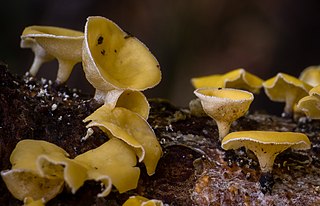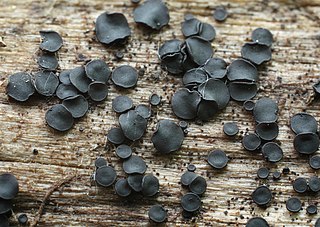
The Nectriaceae comprise a family of fungi in the order Hypocreales. It was circumscribed by brothers Charles and Louis René Tulasne in 1865. In 2020, an Outline of fungi was produced and listed 70 genera and about 1,336 species.

Phyllachoraceae is a family of sac fungi.

The Pyronemataceae are a family of fungi in the order Pezizales. It is the largest family of the Pezizales, encompassing 75 genera and approximately 500 species. Phylogenetic analyses does not support the prior classifications of this family, and suggest that the family is not monophyletic as it is currently circumscribed.

The Hyaloscyphaceae are a family of fungi in the Helotiales order. Species in this family have a cosmopolitan distribution, and are saprobic, growing on dead wood and other plant matter.
Kalmusia is a genus of fungi in the family Didymosphaeriaceae. The genus was formerly placed in family Montagnulaceae, before that was dissolved. The widespread, genus was estimated to contain about 12 species in 2008, which has increased to 29 species in 2023.
Wettsteinina is a genus of fungi in the class Dothideomycetes. The type species Wettsteinina gigantospora was first described by Franz Xaver Rudolf von Höhnel in 1907. The relationship of this taxon to other taxa within the class was unknown in 2008, until it was resolved and placed in the Pleosporaceae family.
Phomatospora is a genus of fungi within the class Sordariomycetes, and since 2016, in the family Phomatosporaceae and order Phomatosporales. They are found in terrestrial, freshwater and marine habitats, across the world except Russia and Canada.

The Meliolaceae are a family of fungi in the order Meliolales. Mostly tropical in distribution, species in this family are biotrophic on the leaves and stems of plants. Despite this, most species do not cause extensive damage to the host plant, and are not generally considered to be of economic significance.
Appendiculella is a genus of fungi in the family Meliolaceae. About 70 species are accepted in 2020.
The Asterinaceae are a family of fungi in the class Asterinales.
Didymosphaeria is a genus of fungi in the family Didymosphaeriaceae.
Lichenopeltella is a genus of fungi in the class Dothideomycetes with 48 species. Its classification is incertae sedis with respect to familial and ordinal placement within the class. It may be in Trichothyriaceae.
Keissleriella is a genus of fungi, that was originally placed in the Massarinaceae family, before being placed in the Lentitheciaceae family.

Lachnellula is a genus of fungi in the family Lachnaceae. The genus contains 40 species. Lachnellula was circumscribed in 1884 by Petter Karsten, with Lachnellula chrysophthalma assigned as the type species.

Rutstroemia is a genus of fungi in the family Rutstroemiaceae. It was circumscribed by Petter Karsten in 1871.

Sillia is a genus of fungi within the Sydowiellaceae family.
The Niessliaceae are a family of fungi in the phylum Ascomycota, class Sordariomycetes. The family was updated in 2020.
Phaeochora is a genus of fungi within the family Phaeochoraceae.

Patellaria is a genus of fungi in the family Patellariaceae. The genus was circumscribed in 1822 by mycologist Elias Magnus Fries with Patellaria atrata assigned as the type species.








